.jpg)
Dear Members (a note from Deb Hickey):
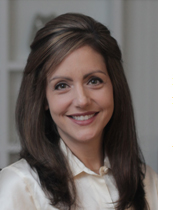 I worked for an Internet marketing company for 12 years as director of marketing. I started when the company was brand new, so I had the opportunity to wear lots of hats and learn many disciplines.
I worked for an Internet marketing company for 12 years as director of marketing. I started when the company was brand new, so I had the opportunity to wear lots of hats and learn many disciplines.
In addition to formulating basic marketing strategies, managing budgets, and working to improve website traffic, I handled the company branding, including everything from creating the logo and picking our company color scheme to choosing the office furniture and designing the marketing collateral. Our unique, two-story tradeshow booth was also my responsibility. I had a lot of fun traveling the country, hobnobbing with the marketing and advertising elite.
I was doing something I enjoyed, and our company grew and prospered. But something was missing. These were all fun and rewarding responsibilities, but I wasn’t connecting with people on a personal level. I didn’t go home at the end of the day feeling that I made a real difference—until now.
Last month I received the following message from a new BOB member’s wife:
You won’t remember me with all the people you deal with, but I will never forget you … You helped me when our life was so chaotic when my husband’s cancer diagnosis came … You were our angel … You answered our questions; you gave us resources; you helped us in our time of struggle … I just have to thank you again and again … You were so important in our journey! You gave us hope. Do you know that? You are the first person people talk to [after they are diagnosed] and your warmth and caring is like a breath of God.
In 2010, my father, Bob Marckini, asked me to leave my job at the Internet marketing firm and work with him. He said, “My offer isn’t without risk. You won’t be making a big salary and I can’t promise you job security. But what I can promise is that you will help people every day and this will bring you great satisfaction and joy.”
I know, now, that I am where I’m supposed to be. I love our members and enjoy our correspondence; I enjoy communicating with newly diagnosed men and their significant others. And I enjoy managing the BOB website and Facebook profile and helping to create our monthly BOB Tales newsletter.
I have firsthand knowledge of the dreaded cancer diagnosis. I’ve been there as a daughter and as a wife and can understand the palpable fear and anguish that comes with that diagnosis. Working with newly diagnosed men and their families, as well as our wonderful members, for the past six years has been energizing and personally rewarding.
Last month my father celebrated his 73rd birthday and in June, he and my mother will celebrate their golden wedding anniversary. As my father begins to back away from his 24/7 commitment to this ministry, I plan to continue taking up the slack, with his guidance, going forward. I’m looking forward to this journey.
This month’s newsletter includes some interesting information on focal treatment for prostate cancer. Learn what it is, when it can be used, why it may be beneficial for some, and what the critics say. Also, learn about the benefits of taking aspirin to reduce your risk of advanced prostate cancer. Learn why eating chicken and eggs may increase the risk of prostate cancer progression. And read why a vegetarian way of life may significantly reduce the risk of developing prostate cancer.
In this issue, we also bring back (and update!) one of our most requested articles of all time—Bob Marckini’s Personal Health Choices, originally written in 2011. In the article, Bob discusses his diet, exercise regimen, and the supplements he takes. He also recommends three life-changing books about diet and lifestyle changes you can make to prevent, and possibly reverse, certain diseases such as cancer, diabetes, coronary artery disease, and autoimmune disease.
I hope you enjoy this month’s newsletter. As always, we welcome your feedback and suggestions for future newsletters. Just send an email to [email protected].
Deb Hickey
To print the BOB Tales newsletter or view the newsletter with a larger font size, click here for the PDF file.
In This Issue:
- Latest developments in focal treatment for prostate cancer
- Aspirin may lower risk of advanced prostate cancer
- Vegetarian diet may protect against prostate cancer
- Eating chicken and eggs may increase risk of prostate cancer progression
- BOB member receives LLUH Distinguished Service Award
- Bob Marckini’s personal health choices
- Only 2.7 of U.S. adults are healthy
- The exercise you should be doing daily
- How to reduce your risk for colon cancer
.jpg)
Latest Developments in Focal Treatment for Prostate Cancer
Dr. Charles Myers’ most recent newsletter, Prostatepedia (April 2016, Volume 1, No. 3), was devoted entirely to the subject of treating prostate cancer with focal therapy.
Dr. Myers interviewed five experts in the field, including Dr. Mark Emberton, professor in interventional oncology at University College, London; Dr. Samir Taneja, co-director of the Smilow Comprehensive Prostate Cancer Center and director of the Division of Urologic Oncology at the NYU Langone Medical Center; Dr. Behfar Ehdaie, a urologist at Memorial Sloan Kettering Cancer Center; Dr. Michael Koch, chairman of the department of urology at Indiana University School of Medicine; and Dr. John Feller, radiologist at Desert Medical Imaging in Indian Wells, CA.
Some physicians prefer to use the term “partial gland ablation” rather than focal therapy because the procedure typically involves not only ablating the tumor, but also a margin of healthy tissue around the tumor to ensure all cancer cells are destroyed. Focal therapy is a new and evolving technology. Most patients treated with focal therapies today are part of clinical trials.
The objective of focal therapy is to control cancer while minimizing side effects, specifically sexual performance and urinary function. A secondary objective is to ensure subsequent whole-gland treatment, such as radiation or surgery can be performed if the focal treatment fails. The ideal candidates for focal treatment are those with relatively early to moderate stage disease.
Most doctors agree that very early stage disease should be followed with active surveillance depending on certain factors. And the entire prostate (whole gland) should be treated if the disease is moderate risk or advanced. This leaves patients in the in-between category as possible candidates for focal prostate cancer therapy.
New, state-of-the-art, advanced imaging, such as 3-Tesla multi-parametric MRI, is the breakthrough that makes focal therapy possible. Doctors are able to see tiny lesions within the prostate, which first can be targeted by biopsy, and later ablated (destroyed) by any one of several forms of focal therapy.
Focal therapies can be divided into two categories: Thermal and non-thermal. There are several types of thermal and non-thermal focal therapies, each with a different source of energy. These include high intensity focused ultrasound (HIFU), radiofrequency ablation (RFA), irreversible electroporation, vascular targeted photodynamic therapy (VTP), focal cryotherapy, focal laser ablation (FLA), and, although Myers’ newsletter didn’t cover it, focal proton therapy. There is even a Phase-I clinical trial under way where doctors inject a toxic agent into the lesion in the prostate in an attempt to destroy the cancer.
Researchers are also looking at using focal therapies for salvage treatment. Since newer imaging techniques can often identify the exact location of the recurrence, it is believed that focal therapy may be an effective way of treating some recurrences. This is potentially a huge benefit, as most salvage therapies that treat the entire prostate often result in significant life-altering side effects. Proton salvage therapy is a notable exception.
Critics of focal therapy argue that not all prostate cancer can be seen, even with advanced imaging techniques, and therefore, whole-gland treatment gives the patient a better chance of long-term survival. Another criticism is that there is no long-term data on focal therapy.
Others point out that each type of focal therapy has its own challenges. Each energy source has pluses and minuses. Cryotherapy and HIFU, for example, have higher risks of collateral damage and scarring than non-thermal techniques.
Bottom Line
Focal therapy has enormous potential. It is investigational, it’s changing rapidly, and there is no long-term data on its effectiveness. However, we believe newer imaging technologies along with evolving focal therapy technology will make partial gland ablation a viable option in the future for treating recurrent prostate cancer as well as some primary cancers.
We will continue to follow this technology and provide periodic updates.
Aspirin May Lower Risk of Advanced Prostate Cancer
According to a new study presented at the American Society of Clinical Oncology Genitourinary Cancers Symposium in San Francisco, men who took more than three aspirin a week reduced their risk of dying from prostate cancer. In the beginning of the study, patients were taking a 325 mg dose three times a week. Later, some patients switched to an 81 mg dose.
Among men with early-stage prostate cancer, aspirin helped decrease the risk of developing advanced prostate cancer by 24 percent. It also lowered the risk of dying from prostate cancer by 39 percent. Researchers examined over 22,000 men enrolled in the Physicians’ Health Study, which began in 1982.
A total of 3,193 men were diagnosed with prostate cancer over the course of the study. Just over 400 of them developed lethal prostate cancer. Lethal prostate cancer was defined as either death from prostate cancer or the spread of prostate cancer to other organs.
In addition to alleviating pain and inflammation, aspirin prevents platelets from binding together during the blood clotting process. Because of this, the researchers believe that aspirin may help fight prostate cancer progression by preventing tumor cells from metastasizing to bone.
You should always consult your doctor before taking any new supplements.
Vegetarian Diet May Protect Against Prostate Cancer
World Cancer Research Fund recently reported on a study conducted at Loma Linda University involving more than 26,000 men. The study examined the association between dietary patterns and prostate cancer incidence.
The specific diets evaluated in the study included non-vegetarian, lacto-ovo-vegetarian, pesco-vegetarian, vegan, and semi-vegetarian. The study did not look at specific food items, but rather the overall diet itself.
The study found that men who chose a vegan diet had a 35 percent reduced risk of prostate cancer.
This is consistent with other studies we have reported that showed red meats, processed meats and animal fats are associated with a higher incidence of prostate cancer.
Eating Chicken and Eggs May Increase Risk of Prostate Cancer Progression
According to Harvard University researchers, men who eat chicken and eggs are more likely to die from prostate cancer. In the study, 1,000 men with early-stage prostate cancer were followed for several years. The study found that men who ate two-and-a-half or more eggs per week had twice the risk of their cancer progressing.
Eating poultry was found to have a similar effect. Men with a more advanced form of the disease who regularly ate turkey or chicken had four times the risk of metastasis.
Eggs contain the compound, choline. High levels of choline in the blood are thought to trigger the spread of prostate cancer. The risk created by poultry could be linked to the carcinogens in cooked meat, known as heterocyclic amines (HCAs).
BOB Comment: Even with this evidence, there are others, such as the Mayo Clinic and prostate cancer expert, Dr. Charles Myers, who promote the Mediterranean Diet, which includes the consumption of chicken. You will see reference to this later in this newsletter.

Upcoming: Pacific Northwest BOB Reunion and Golf Event, Portland, OR
When:
Thursday, May 26, 2016--|--Golf first tee time: 10:00 a.m.--|--Dinner & Reunion: Doors open at 5:30 p.m. (Dinner at 6:30 p.m.)
Where:
Golf: Chehalem Glenn Golf Course, 4501 E. Fernwood Rd., Newberg--|--Dinner: Portland Adventist Medical Center, 10123 S.E. Market Street, Portland
Details:
These events are open to all BOB members and their guests. The golf event is not a tournament—it’s just for fun. The cost is $40/player; this includes 18 holes with a power cart.
The dinner/reunion will feature a program by Lynn Martell, D.Min, Director of Special Services at Loma Linda University Health. The full buffet, including two vegetarian entrees, salad, and dessert, is $20/person.
RSVP:
Download, print, and fill out registration forms for the dinner and golf event (Payment for golf may be included with dinner payment). Mail your registration(s) with payment no later than May 15, 2015. Checks should be made out to: Gary D. Brown with “BOB Event” in the memo and mailed to: Gary D. Brown, 115 Nicholas Way, Newberg, OR 97132-2353
For more information, if you need assistance with registration, or if you have questions, email Gary at [email protected] or call 503-538-8885.


Member Feedback
We received a lot of feedback following last month’s newsletter. As usual, many were following up on our brain teaser question, but we also received numerous messages about our group in general, as well as comments about the article on Roger Wright and his incredible story of weight loss and transformation. Below are a few examples:
I finished my 45 treatments in November of 2014. What a blessing to be treated at Loma Linda University Cancer Center. Prior to treatment, my PSA level was at 5.7. After treatment, it is now 0.10. And, I have had zero side effects. Wow!
My urologist in Phoenix diagnosed me with cancer of the prostate in 2010. He stated, "You have a lot of cancer." It didn’t look good. Luckily, my wife and I found out about proton therapy and I was treated in 2011. Today, my PSA is low and holding. I am thrilled to have reached the five year mark! Peace and love to all my brothers and sisters.
Deb: The work that you and your dear family do for others means so much to everyone. And, what a wonderful story (and video) about Roger in this most recent newsletter! Congratulations to a great winner in many ways! By the way, I am a strong supporter of cystic fibrosis and I will continue in Julia’s honor, too.
Bob and Deb: Thanks for the newsletter. I have run out of adjectives to express all my feelings for all that you do. I just want to say that I never laughed harder at seeing the photo of Bob and the fish (with the caption included).
Life is good. My wife and I are celebrating our 55th anniversary this month. And I am a 13-year survivor of prostate cancer post-proton treatment at LLUCC. I get a couple of emails from prospective proton patients each month. I love answering their questions.
Ambassador Reed Honored by LLUH
By Larry Kidder, LLUH, Public Affairs
Joseph Verner Reed Jr., who served under four U.S. presidents and four United Nations secretaries-general, was recently presented with the Loma Linda University Health (LLUH) Distinguished Service Award.
Reed is best known for his ambassadorial role to Morocco under President Ronald Reagan, and for serving as chief of protocol under President George H.W. Bush. He is considered the consummate diplomat.
Ambassador Reed has never forgotten the care he and his wife received at Loma Linda University Cancer Center (LLUCC). He was treated for prostate cancer with proton therapy in 1997. Later, his wife, Marie “Mimi” Reed, was also treated at LLUCC for cancer. Mimi, who passed away July 17, 2015, and the ambassador were married for 56 years.
On Monday, April 11, 2016, at 11:00 a.m., Richard Hart, MD, DrPH, president of LLUH, personally presented Ambassador Reed with the organization’s highest honor, the Distinguished Service Award, during a quiet ceremony in Reed’s home in Greenwich, CT. With them were LLUH’s executive director of public affairs, Garrett Caldwell, DMin, and several of Reed’s personal staff.
Had he been able to travel to Loma Linda, CA, Ambassador Reed would have received the Distinguished Service Award during Loma Linda University commencement ceremonies. Reed responded: “I’m so glad to receive you here in my home in Greenwich. I’m only sorry that I cannot go to Loma Linda, where I would have been honored to receive this in person.”
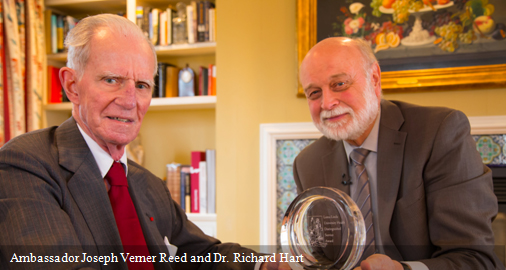
Bob Comment: Ambassador Reed has been a member of the BOB for 14 years and is an avid fan or the BOB Tales newsletter, which he reads cover to cover each month.
.gif)
We have been producing BOB Tales newsletters monthly for almost 16 years. During this time there have been some important articles that many new members have not seen, and some older members may have forgotten. So, we decided to periodically re-run some articles from past newsletters. This one is from September 2011. It answers one of the most often asked questions from our members: “What does Bob Marckini do to stay healthy?”
Prevent Recurrence: Bob Marckini’s Personal Health Choices
Two of the most common questions I am asked are, “Is there anything I can do to prevent prostate cancer?” and “Is there anything I can do to prevent a recurrence of my prostate cancer?”
Medical researchers don’t know for sure what causes prostate cancer. But they do know there is a strong genetic component. They also know that diet and lifestyle are contributing factors. So, short of selecting different parents, there are some things you can do that may influence the onset—or progression of—prostate cancer.
In my book, in chapters 1, 9, 11, and 16, I cover this subject in detail. I will summarize it here along with new information I have learned since the book was published.
Over the past 11 years, I have read just about everything I could find on the relationship between diet, lifestyle, and cancer. One of the most important things I learned is that during the course of our lives, numerous cancers and other diseases enter our bodies. Most, if not all, never gain a foothold because they are destroyed by our immune system. So, the obvious question is: What can we do to keep our immune system strong? The simple answer is:
- Eat a healthy diet
- Maintain proper body weight
- Exercise regularly
- Maintain a positive mental attitude
While our focus here is on No. 1—eat a healthy diet—here is a word or two about the other three:
Maintain proper body weight:
Obesity has been linked to numerous diseases, including cancer in general, and prostate cancer in particular. The rule of thumb here is—weigh what you ought to weigh.
Choose a diet and exercise plan that you and your doctor feel is right for you, and lose the extra pounds. Easier said than done?
Exercise regularly:
Daily physical activity is important for overall good health. Thirty minutes a day of moderate workout, such as brisk walking, bike riding, or water aerobics is recommended by the World Health Organization. But even more leisurely activities, such as yard work, have their benefits. A recent study in Taiwan reports that even as little as 15 minutes of exercise each day can reduce the risk of death by 14 percent and extend life expectancy by three years compared with those who did no exercise.
Maintain a positive mental attitude:
The Harvard School of Public Health and the Mayo Clinic have linked a positive mental attitude to lowered risk of heart disease and a slowing of the aging process. The American Cancer Society reports that a positive mental attitude improves the immune response. They even go so far as to say that, “Being part of a support group following cancer treatment improves quality of life and enhances patient survival.” Aren’t you glad you joined the Brotherhood of the Balloon?
The Important Diet Connection
About five years ago I had the pleasure of meeting Hans Diehl, Dr. HSc, MPH. At the time, Hans was Director of the Lifestyle Medicine Institute at Loma Linda University Cancer Center. He has done pioneering work with Nathan Pritikin and Dr. Denis Burkitt on diet, lifestyle, and disease. Dr. Diehl is also the founder of the Coronary Health Improvement Project (CHIP).
 Dr. Diehl gave me a copy of his book, “Health Power: Health by Choice Not Chance,” and also recommended I read “The China Study” by T. Colin Campbell. I read both books and they had a profound impact on me.
Dr. Diehl gave me a copy of his book, “Health Power: Health by Choice Not Chance,” and also recommended I read “The China Study” by T. Colin Campbell. I read both books and they had a profound impact on me.
I learned from these books and other research, that with diet and lifestyle changes, you may not only prevent certain diseases, such as cancer, diabetes, coronary artery disease, and autoimmune disease, you might even be able to reverse them.
Western diets, including those with high levels of fat from red meat and whole dairy products, have been shown to increase the risk of prostate cancer and other cancers. Excessive sugar, alcohol, and refined flour also contribute to these diseases.
The recommended diet is one that includes several servings a day of fruits and vegetables, especially cruciferous vegetables, such as broccoli and cauliflower. Soy products, cereals and other whole grain products are also recommended as cancer preventers.
In “The China Study,” Campbell recommends a whole-food, plant-based diet exclusively. He presents considerable data supporting his theory that 1) you can have a completely balanced diet without consuming animal products and; 2) a diet such as this can prevent diseases and reverse diseases.
Other experts in the field, such as Dr. Charles “Snuffy” Myers, recommend the Mediterranean diet for preventing prostate cancer. The Mediterranean diet consists of whole grains (wheat, oats, rice, barley), vegetables (raw and cooked), fruits, olives and olive oil, nuts, beans (legumes), seeds, herbs, spices, fish, shellfish, eggs, lean cuts of some meats and poultry, water and some wine.
An LLUH study linked higher levels of tomato consumption to protection against prostate cancer. Tomatoes contain lycopene. Higher levels of lycopene in the blood are associated with lower prostate cancer rates.
A Harvard University study identified tomatoes as one of the most “productive” foods you can have in your diet. Lycopene is also found in watermelon.
Vitamin D3 has been shown to reduce the likelihood of developing prostate cancer. Dr. Myers often recommends relatively large doses of D3 to patients with recurrent prostate cancer as a way of slowing down disease progression. When sunlight exposure alone doesn’t provide sufficient vitamin D3, supplements may be appropriate.
My Diet (Updated)
Before I was diagnosed with prostate cancer I ate a reasonably healthy diet. But I have since made several changes, particularly after reading “The China Study” and “Health Power.”
My breakfast usually consists of three to five servings of fruit (bananas, blueberries, strawberries, prunes) and hot or cold cereal with soy milk or almond milk. For lunch, I often use a blender to produce about 16 ounces of juice, with pulp, made from some combination of fruits and vegetables such as carrots, kale, spinach, beets, celery, apples, watermelon, strawberries, blueberries, etc. I also alternate lunches with salads or left-over veggies, or vegetarian soups from the previous night’s dinner.
For dinner we always have a salad with homemade dressing made with extra-virgin olive oil, apple cider vinegar, and spices. We eat an assortment of home-made soups made mostly with fresh vegetables. Chicken, fish, brown rice, and potatoes are on the menu maybe once a week. We have lots of fresh vegetables, such as broccoli, cauliflower, green beans, and legumes (peas, black beans, cannoli beans, kidney beans, lentils). Cooked and raw tomatoes are frequently part of our dinners. Whenever possible, the fruits and vegetables are organic. I have eggs and grass-fed red meat occasionally, but consume these foods much less often than in the past.
During the day I sometimes snack on a handful of nuts (almonds, pistachios) and have two or three cups of green tea. I also drink three or four glasses of water a day.
Supplements and Exercise
I take a low-dose aspirin, lycopene, vitamin C, vitamin D3, pomegranate extract, and fish oil. Are all these necessary? Probably not, but it works for me.
I also exercise in some way for about 45 minutes six days a week. I swim a mile, three times a week at the “Y,” and in-between, I either exercise at the gym or fast walk outside or on my treadmill.
Summary (Updated)
I truly believe in the adage: You are what you eat. I’m convinced that with proper diet and lifestyle choices one can prevent cardiovascular disease, diabetes, many cancers, and the recurrence of cancer. It’s all about keeping your immune system strong. To strengthen your immune system, you should maintain proper body weight, exercise at least 30 minutes a day, work to maintain a positive mental attitude, and eat a healthy diet.
I highly recommend reading “The China Study,” “Health Power,” and a book we will soon be reporting on, “Anticancer.”
Check with Your Doctor
You should always check with your doctor before embarking on an exercise program or taking over-the-counter supplements. You may recall from last month’s newsletter, supplements are drugs too. They vary in quality and can interact with other medications you may be taking.

.jpg) LLUH’s Vision 2020 Funding Progress
LLUH’s Vision 2020 Funding Progress
About two years ago, Loma Linda University Health (LLUH) announced an extremely ambitious initiative called Vision 2020. This effort involves construction of a new state-of-the art adult hospital, expansion of the Children’s Hospital, significant growth in scholarships, research, endowments, and other capital projects.
This $1 billion initiative was given a head-start through a leadership gift of $100 million from Dennis and Carol Troesh. Funding of the remainder is planned through several sources, including a $360 million fund raising campaign. To date, many millions of dollars have come in from thousands of donors all over the world, from small cash gifts to large gifts of tens of thousands of dollars. More than 1,000 employees of LLUH have contributed as well as many of our members. This is just one way we can give back to the institution that saved our lives and preserved the quality of our lives.
Dr. Richard Hart, President of LLUH, recently said:
I believe there is no greater opportunity than the gift of giving and participating in something that you believe in. We are deeply grateful to those who have the means to enable us to reach our Vision 2020 goals. Whether it’s large or small, the act of participating and giving lets us all take part in this dream for our future.
If you are interested in supporting Vision 2020 with a gift, either a cash gift or a planned gift through your estate, please see below.
How to Contribute to Vision 2020
Give Now: Visit the Vision2020 website and donate online.
Make a Future Gift: Contact Todd Mekelburg at the Office of Planned Giving at Loma Linda University Health at 909-558-5376 or email [email protected].
New Member Donates to Vision 2020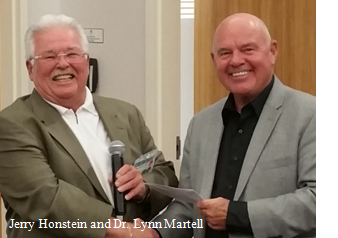
New BOB member and recent “graduate” of LLUCC’s proton therapy treatment program Jerry Honstein presented Dr. Lynn Martell with a significant donation for Vision 2020 at a recent Wednesday night meeting. Here is an excerpt from a letter Jerry sent to Dr. Martell after his treatment ended.
I was challenged by friends and physicians about my choice of treatment. “Are you certain you want to take part in this ‘experimental program’?” LLUCC just celebrated its 25th anniversary. Today there are 22 other proton treatment centers in the U.S. Experimental program?!
My proton treatment at LLUCC morphed into a blessed life experience … The only other time I felt such a bond between brothers was during my time in the military.
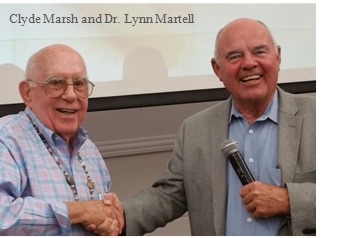 Clyde Contributes Again and Again
Clyde Contributes Again and Again
BOB member Clyde Marsh was treated with proton therapy for his prostate cancer in 2007 at LLUCC. He and his wife, Sylvia, have been “giving back” ever since. Both run the Tuesday Night Potluck Dinners at the Loma Linda Springs apartment complex. They have been doing so for almost ten years
Clyde’s overall goal is to help patients and their families “step back from their medical situation” and take part in a fun night of good fellowship. The group also collects money to donate to proton research and has made numerous donations over the years.
Recently Clyde presented yet another check to the Robert J. Marckini Chair for proton research at LLUCC.
How to Contribute to Proton Research
Give Now: Visit the LLUH website and donate online. Make sure the “Designation Type” is set to “Proton” and the “Designation” is set to “Robert J. Marckini Chair.
Send a Check: Make your check out to “LLUCC Proton” with “Marckini Chair” in on the memo line and send to:
LLUH, Office of Philanthropy
P.O. Box 2000
Loma Linda, CA 92354.
Make a Call: Contribute by phone. Contact Elvia DeHaro at 909-558-5010

Only 2.7 Percent of U.S. Adults are Healthy
A study conducted by Oregon State University, the University of Mississippi and the University of Tennessee at Chattanooga has awarded nearly every adult in the country a failing grade.
Researchers used four health barometers: 1) Balanced diet, 2) being active, 3) proper body fat percentage, and 4) not smoking. Using data from the 2003-2006 National Health and Nutrition Examination Survey data, they found that 97.3 percent of the 4,745 people they looked at did not meet the criteria.
Many people met one or more of the criteria. Eleven percent were in the “supremely unhealthy” range, meeting zero percent of the goals; 34 percent met one goal; 37 percent met two; 16 percent met three; but only 2.7 percent met all four goals.
According to researchers, meeting all four goals is important because these factors have been linked to increased risk of cardiovascular disease and other medical conditions.
The Exercise You Should be Doing Daily
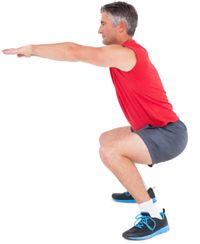 Squatting is not everyone’s favorite activity. However, squatting exercises can do a lot more for your body than just toning and building leg muscles according to Chris Stepien MD, DC, CSCS, CAPP of Barefoot Rehabilitation Clinic in Parsippany, NJ.
Squatting is not everyone’s favorite activity. However, squatting exercises can do a lot more for your body than just toning and building leg muscles according to Chris Stepien MD, DC, CSCS, CAPP of Barefoot Rehabilitation Clinic in Parsippany, NJ.
Dr. Stepien feels the squat is a natural movement humans should be doing every day, throughout the day, “like flossing your teeth.” Squatting, in small doses every day, helps maintain flexibility and strength. He suggests building up to doing 10 squats when you wake, after lunch, after work, and before
bed. But start slowly, he warns.
When doing squatting exercises, Stepien says to make sure you do not allow your knees to cave in towards each other or your heels to come off the floor. “Start in a smaller range of motion and groove that pattern over the duration of a few days. As your comfort increases, increase the range of motion to gently introduce complexity to the movement.”
NEW “Live It” Video: Colon Cancer
Loma Linda, CA has been designated a “blue zone” by National Geographic as one of the five communities in the world with the longest-living inhabitants. Residents of Loma Linda are 10 times more likely to make it to 100. So, perhaps we should pay attention to how they live their lives.
Recently, Loma Linda University Health (LLUH) began including a new video series called “Live It” in their weekly newsletter to staff, students, and friends. The short videos include tips for longer and healthier living and we will occasionally share them with our readers as appropriate.
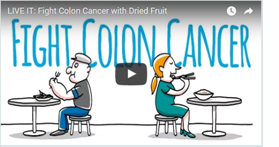 Video: How to Reduce Your Risk for Colon Cancer
Video: How to Reduce Your Risk for Colon Cancer
Many may remember being told as a child to eat your greens because they make you healthy and strong. Well, even as an adult this idea still holds true. In fact, pairing it up with dried fruit, legumes and brown rice may build a protective barrier against colon cancer.
Health Journalist, Patricia Kelikani, and Surgical Oncologist, Dr. Mark Reeves, discuss in detail how and when you should consume certain foods in order to prevent the risk of colon polyps that lead to colon cancer.

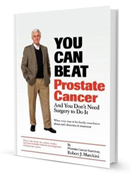
Eleven Proton Centers Now Give Our Book to Patients
Eleven proton centers in the U.S. provide copies of our book to men and their families who make inquiries about proton therapy. We know our book is making a difference. A growing number of men who register for membership in our group inform us that it was our book that convinced them that proton was the best option for them. Nothing makes us happier.
Write a Review!
“You Can Beat Prostate Cancer: And You Don’t Need Surgery To Do It” is still hovering between the No. 3 and No. 4 position on a search for “prostate cancer” on Amazon.com out of more than 30,000 search results. It has surpassed 250 reader reviews—still more than any other book in the top 50.
 Was Bob’s book helpful to you? Have you written an Amazon review yet? If not, please post a review today and help us get to 300!
Was Bob’s book helpful to you? Have you written an Amazon review yet? If not, please post a review today and help us get to 300!
Thank you, “MasterQ,” “Michael,” and “BoosMom,” for recently posting reviews on Amazon. The more quality reviews; the higher the book ranks in their search engine; the easier it is for newly diagnosed men to learn about proton therapy for prostate cancer. Once you are logged into your Amazon account, click here and click “Create your own review” button. Write a short paragraph, and don’t forget to rate the book from one to five stars!
One Member Recently Emailed Deb…
I have given a couple of talks about prostate cancer and proton treatment at local community groups. I have given away Bob’s book several times to interested attendees. It will always be the number one best seller as far as I’m concerned.
Buy Online, in Bulk or in Spanish
Online: Paperback: $19.00--•--Kindle: $9.99--•--NOOK Book: $9.99--•--Apple iBook: $9.99
In Bulk: Conctact us for a discount price list. Proceeds from book sales support proton therapy research through the Robert J. Marckini Endowed Chair at LLUCC.
In Spanish: Buy the print version or in eBook format.

Did You Know
The Word, “Gullible”—Not in the Dictionary?
Last month we had a little fun with our members. We wanted to see how gullible some of you are. So, in our “Did You Know” series, we stated, “The word ‘gullible’ is not in the dictionary.” And, sure enough, some of our “gullible” members looked up the word and reported to us that we had made a mistake. The joke was on them!
Some Interesting Golf Statistics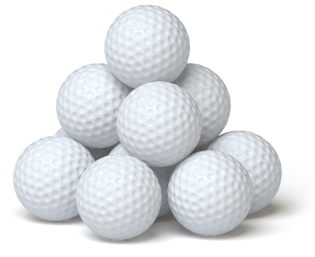
- 125,000 golf balls a year are hit into the water at the famous 17th hole of the Stadium Course at Sawgrass (That’s almost as many as Bob Marckini lost in the woods last year!).
- The longest drive ever is 515 yards. The longest putt ever is a monstrous 375 feet.
- Phil Mickelson, who plays left-handed, is actually right-handed. He learned to play golf by mirroring his father’s golf swing, and he has used left handed golf clubs ever since.
- The longest golf course in the world is the par 77 International Golf Club in Massachusetts, which measures a fearsome 8,325 yards.
- The longest golf hole in the world is the 7th hole (par 7) of the Sano Course at the Satsuki Golf Club in Japan. It measures an incredible 909 yards.
- The first golf balls were made of thin leather stuffed with feathers. Tightly-packed feathers made balls that flew the farthest. Feather balls were used until 1848.
- Don't feel bad about your high handicap—80 percent of all golfers will never achieve a handicap of l8 or less.

Last Month’s Brain Teaser
Say that 100 pennies are on a table. Ninety of them are heads and 10 are tails. With your eyes closed, can you separate all the coins into two groups so that each group has the same number of tails?
Answer: Take any 10 pennies and turn them over. They’re group number 1. The rest
of the pennies are group number 2. Don’t believe it? Give it a try.
Here’s an example: Remember, 90 are heads and 10 are tails, let’s say that while blindfolded, the 10 pennies you selected included two that were tails and eight that were heads. That left 90 pennies, which includes the remaining eight that were tails. When you flipped over the 10 coins you selected, the eight that were originally heads became tails, and the two that were tails became heads. Now both groups (the group of 90 pennies and the group of 10 pennies) have eight pennies that are now tails. This will work with any 10 pennies you remove from the original group of 100.
No Winner! We had tons of guesses this month, but for the first time in BOB Tales brain teaser history, no one guessed correctly.
New Brain Teaser
What do these words have in common?
congregation, shrewdness, company, colony, grist, clowder, brace, memory, skein, shiver, murder and dray
Send your brain teaser answers to [email protected] for a chance to win a signed copy of Bob’s book.
Three Sons
A father told his three sons when he sent them to the university, “I feel it’s my duty to provide you with the best possible education, and you do not owe me anything for that. However, I want you to appreciate it. As a token, please each put $1,000 into my coffin when I die.”
And so it happened. His sons became a doctor, a lawyer, and a financial planner. Each was very successful financially. When their father’s time had come and they saw their father in the coffin, they remembered his wish.
First, it was the doctor who put ten $100 bills onto the chest of the deceased.
Then the financial planner also put $1,000 into the coffin.
Finally, it was the heartbroken lawyer’s turn. He dipped into his pocket, took out his checkbook, wrote a check for $3,000, put it into his father’s coffin, and took the $2,000 cash.
He later went on to become a member of Congress.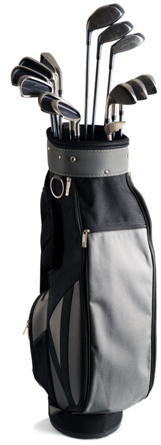
Man: Caring and Sensitive
The room was full of pregnant women with their husbands.
Instructor: “Ladies, remember that exercise is good for you. Walking is especially beneficial. It strengthens the pelvic muscles and will make
delivery that much easier. Just pace yourself, make plenty of stops, and try to stay on a soft surface like grass or a path. And gentlemen!
Remember, you’re in this together. It wouldn’t hurt you to go walking with her. In fact, that shared experience would be good for you both.”
The room suddenly became very quiet as the men absorbed this information. After a few moments a man at the back of the room,
slowly raised his hand. “Yes?” said the Instructor.
“I was just wondering if it would be okay if she carries a golf bag.”
Brings a tear to your eye, doesn’t it?
.jpg)
The Good Ol’ Days
When I was a boy, my mamma would send me down to the corner store with one dollar and I’d come back with five potatoes, two loaves of bread, three bottles of milk, a hunk of cheese, a box of tea, and six eggs. You can’t do that now—too many security cameras.
Quote of the Month
“My grandfather once told me that there were two kinds of people: Those who do the work and those who take the credit. He told me to try to be in the first group; there was much less competition.” — Indira Gandhi

Children of the ‘30s & ‘40s: “The Last Ones”
A Memoir, by Carl D. Peterson
Born in the 1930s and early ‘40s, we exist as a very special age cohort. We are the “last ones.” We are the last, climbing out of the depression, who can remember the winds of war and the war itself with fathers and uncles going off. We are the last to remember ration books for everything from sugar to shoes to stoves. We saved tin foil and poured fat into tin cans. We saw cars up on blocks because tires weren’t available. My mother delivered milk in a horse-drawn cart.
We are the last to hear Roosevelt’s radio assurances and to see gold stars in the front windows of our grieving neighbors. We can also remember the parades on August 15, 1945: VJ Day.
We saw the “boys” home from the war build their Cape Cod-style houses, pouring the cellar, tar papering it over and living there until they could afford the time and money to build it out.
We are the last who spent childhood without television. Instead we imagined what we heard on the radio. As we all like to brag, with no television, we spent our childhood “playing outside until the street lights came on.” We did play outside and we did play on our own. There was no little league.
The lack of television in our early years meant, for most of us, that we had little real understanding of what the world was like. Our Saturday afternoons, if at the movies, gave us newsreels of the war and the holocaust sandwiched in between westerns and cartoons. Newspapers and magazines were written for adults. We are the last who had to find out for ourselves.
As we grew up, the country was exploding with growth. The G.I. Bill gave returning veterans the means to get an education and spurred colleges to grow. VA loans fanned a housing boom. Pent-up demand coupled with new installment payment plans put factories to work. New highways would bring jobs and mobility. The veterans joined civic clubs and became active in politics. In the late ‘40s and early ‘50’s the country seemed to lie in the embrace of brisk but quiet order as it gave birth to its new middle class. Our parents understandably became absorbed with their own new lives. They were free from the confines of the depression and the war. They threw themselves into exploring opportunities they had never imagined.
We weren’t neglected but we weren’t today’s all-consuming family focus. They were glad we played by ourselves “until the street lights came on.” They were busy discovering the post-war world.
Most of us had no life plan, but with the unexpected virtue of ignorance and an economic rising tide we simply stepped into the world and went to find out. We entered a world of overflowing plenty and opportunity; a world where we were welcomed. Based on our naïve belief that there was more where this came from, we shaped life as we went.
We enjoyed a luxury; we felt secure in our future. Of course, just as today, not all Americans shared in this experience. Depression poverty was deep rooted. Polio was still a crippler. The Korean War was a dark presage in the early ‘50s and by mid-decade school children were ducking under desks. China became Red China. Eisenhower sent the first “advisers” to Vietnam. Castro set up camp in Cuba and Khrushchev came to power.\
We are the last to experience an interlude when there were no existential threats to our homeland. We came of age in the late ‘40s and early ‘50s. The war was over and the cold war, terrorism, climate change, technological upheaval and perpetual economic insecurity had yet to haunt life with insistent unease.
Only we can remember both a time of apocalyptic war and a time when our world was secure and full of bright promise and plenty. We experienced both. We grew up at the best possible time, a time when the world was getting better not worse.
We are the “last ones.”
Low PSAs to all!
Bob Marckini and Deb Hickey
To print the BOB Tales newsletter or view the newsletter with a larger font size, click here for the PDF file.
NO MEDICAL ADVICE: Material appearing here represents opinions offered by non-medically-trained laypersons. Comments shown here should NEVER be interpreted as specific medical advice and must be used only as background information when consulting with a qualified medical professional.
